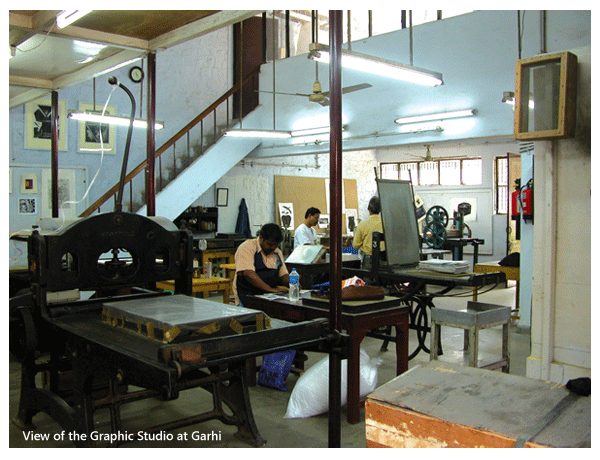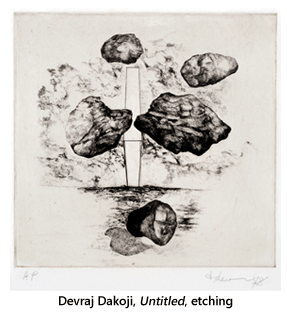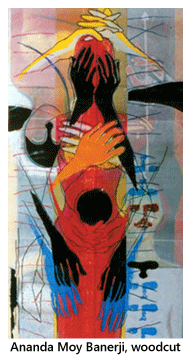- Publisher's Note
- Editorial
- Love of Life (that) Spills Over
- A Continuing Multiplication
- From Painting to Print
- Intimate Involvement
- Portrait of the Artist as an Old Man
- (Hi)Story of the Garhi Printmaking Studios, New Delhi
- Surinder Chadda
- Ramendranath Chakravorty
- Group 8
- Mother and Child: A Screenplay
- Straddling Worlds
- A Brief History of Printmaking at Santiniketan
- Vignettes from History
- Southern Strategies
- The Forgotten Pioneer: Rasiklal Parikh
- Printmaking in the City Of Joy
- Amitabha Banerjee: His Art and Aesthetic Journey
- Local Style and Homogenizing trends: Early Medieval Sculpture in Galaganatha
- English China: Delicate Pallid Beauty
- The Beauty of 'Bilal'
- Photo Essay
- The Way of The Masters: The Great Artists of India 1100 –1900
- Striving Towards Objectivity
- The Art of Sculpting In the Contemporary Times
- An Artistic Framework for an Alternative to Ecology
- Bidriware and Damascene Work in Jagdish and Kamla Mittal Museum of Indian Art
- A Lowdown on the Print Market
- The 'bubble' and the 'wobble'
- What Happened and What's Forthcoming
- Art Bengaluru
- Art Events Kolkata: June – July 2011
- Musings from Chennai
- Mumbai Art Sighting
- Previews
- In the News
- Christie's Jewellery Auction at London, South Kensington
ART news & views
(Hi)Story of the Garhi Printmaking Studios, New Delhi
Volume: 3 Issue No: 19 Month: 8 Year: 2011
by Johny ML

There used to be a time when Garhi Studios, near East of Kailash, New Delhi was the hub of artistic activities in the capital city. Out of the many activities, the most challenging and exciting one was printmaking. Garhi Studios, set up by the Kendra Lalit Kala Akademy (Central Fine Arts Academy) in 1976 under the leadership of late Sankho Chaudhury became the byword for printmaking in the capital city.  Established and young artists gravitated towards the sylvan atmosphere provided by the studio campus and literally there was a revolution in printmaking in Delhi. Today, Garhi studios give a different picture and feel. The activities are still on and artists are still making use of their studio facilities. However there is something that used to bind together the Garhi activities which is terribly missing today. That missing spirit is quite obvious in the Graphics Department (printmaking) too.
Established and young artists gravitated towards the sylvan atmosphere provided by the studio campus and literally there was a revolution in printmaking in Delhi. Today, Garhi studios give a different picture and feel. The activities are still on and artists are still making use of their studio facilities. However there is something that used to bind together the Garhi activities which is terribly missing today. That missing spirit is quite obvious in the Graphics Department (printmaking) too.
“When I came here in 1996, I saw a lot of artists working in the printmaking department,” observes Rajan Fulari, an acclaimed young printmaker and painter who currently takes care of the Graphics Department at the Garhi Studios. “To work with them or to work under their guidance was really a learning experience. You felt like doing more and more works in the printmaking mediums. Today, the youngsters do not find such an atmosphere here. There is a lack of continuity in this stream,” Fulari points out. When we speak of the continuity or the rupture that occurred in it, we should be tracing back to the history of it in order to understand the gravity of today's affairs in this particular stream of art of production within Garhi studios.
In 1976, Devraj Dakoji, a noted printmaker of the time, was looking after the etching section and Joglekar from Baroda was heading lithography. At that point of time there was no silkscreen printing. During Sankho Chaudhury's tenure as the Director of Garhi Studios, he introduced silkscreen printing. Noted painter late Manjit Bawa was the chosen person to set up the silkscreen facilities. G R Santhosh too was there in the studios. Though there were not too many people around, the energy was too high. This department became further more active with the arrival of artists like Surinder Chadda, Tapan Bhowmick, Gogi Saroj Pal and Damodaran by 1977. Veteran artist, Bhavesh Sanyal also used the facilities here. Richard Bartholomew was the secretary of the Lalit Kala Akademy whose presence and influence brought art critics like Prayag Shukla and K G Goel to the studios. Jogen Choudhury also did his silkscreen experiments in Garhi Studios.
At that point of time there was no silkscreen printing. During Sankho Chaudhury's tenure as the Director of Garhi Studios, he introduced silkscreen printing. Noted painter late Manjit Bawa was the chosen person to set up the silkscreen facilities. G R Santhosh too was there in the studios. Though there were not too many people around, the energy was too high. This department became further more active with the arrival of artists like Surinder Chadda, Tapan Bhowmick, Gogi Saroj Pal and Damodaran by 1977. Veteran artist, Bhavesh Sanyal also used the facilities here. Richard Bartholomew was the secretary of the Lalit Kala Akademy whose presence and influence brought art critics like Prayag Shukla and K G Goel to the studios. Jogen Choudhury also did his silkscreen experiments in Garhi Studios.
Interestingly, there were no patrons for printmaking then. If we go by the words of Ananda Moy Banerji, a veteran in Garhi's print making department, 'only the hoteliers used to take graphic prints because they wanted identical works in their hotel rooms.' Despite this lack, or lack of respect for, the medium by the patrons, the artists who chose to become printmakers took it really seriously in Garhi because the studios and the artists who worked there showed a lot of potential,  sincerity and devotion to the printmaking genre. “The Graphics Department in Garhi is still one of the best in the country. But I would always love those days when artists gathered in and around the studios, worked, discussed, exhibited and lived a different life,” says Subbanna, fine printmaker and a veteran in Garhi studios.
sincerity and devotion to the printmaking genre. “The Graphics Department in Garhi is still one of the best in the country. But I would always love those days when artists gathered in and around the studios, worked, discussed, exhibited and lived a different life,” says Subbanna, fine printmaker and a veteran in Garhi studios.
If the first crop of the artists who set up Garhi were not full time printmakers, except for a few, the second generation that entered the space was really cut for the field. Early 1980s saw the arrival of artists like Subbanna, Sushanta Guha, Ananda Moy Banerji, Dattatreya Apte, late Vinod Kumar, Jayant Gajera, Kanchan Chandar, Kunal Sinha and Kavita Nayar. They were later joined by artists like Shukla Sawant and Subba Ghosh. “This was the spring time in Garhi's printmaking department,” remembers Anand Moy Banerji. “We were all experimenting with different aspects of printmaking and also we were extending the boundaries of it. And above all, we were great debaters. Garhi was more like a discussion platform apart from a studio campus,” Banerji says.
“We were all experimenting with different aspects of printmaking and also we were extending the boundaries of it. And above all, we were great debaters. Garhi was more like a discussion platform apart from a studio campus,” Banerji says.
The studio activities are still funded by the Lalit Kala Akademy. In the initial years, the administration used to take care of all the materials. But as time progressed with no revision in the charges and budgeting the age-old funding became almost inadequate. The subsidised charges levied on the artists were totally insufficient and today the Lalit Kala Akademy provides only a few supporting and consumable materials including kerosene needed for printmaking. “To improve the situation there should be a consensus between the artists and the administration and it has not come so far. But I would say, still artists prefer to come in Garhi and work because it could give the best of the facilities in the city,” says one of the veterans in the Studio. The studios are not air conditioned and dust free. “At times you need to pick up insects with your fingers out of your final prints. We have to approach the whole situation professionally. It is a very serious medium, which is highly technical. To deal with such a medium we also should develop certain level of professionalism.”
It is a very serious medium, which is highly technical. To deal with such a medium we also should develop certain level of professionalism.”
The community feeling that once made Garhi's printmaking department successful and famous is slowly fading away. “We used to clean the studios ourselves. We did all sweeping, swiping, dusting and cleaning up of cob-webs. It was a work culture and that contributed a lot towards the success of the printmaking department,” says Ananda Moy Banerji. And the great respect that one felt for the fellow printmaker is still palpable in their words. “Devraj Dakoji was a very involved artist. He used to help everyone to do etchings. Later he went to the Tamarind Studios in the US on a scholarship. He came back in 90s and set up a studio of his own. Later, when he shifted back to the US, the sophisticated machines he had were acquired by the Garhi studios. Now we have the access to those presses also,” says Subbanna.
The camaraderie and community feelings led to the founding of the Indian Printmakers' Guild in 1990. This group was led by artists like Ananda Moy Banerji, Subba Ghosh, Shukla Sawant, Kavita Nayar and so on. This could be seen as the natural outcome of the energies gathered around Garhi's printmaking studios. Garhi, being a government establishment, could not have given the commercial success that the artists wanted. The Printmakers' Guild went on to do ten shows all over India, which were all catalogued, sponsored, and proved to be commercially successful also.
which were all catalogued, sponsored, and proved to be commercially successful also.
After ten shows, the Printmakers' Guild decided to take a break for the time being. Artists dispersed to different regions and areas of working though still continue their discussions and discourses through friendly gatherings. However, the temporary dispersal of the Indian Printmakers' Guild should be seen against the changes that occurred in the Indian art market. With the economic boom, when painting, sculptures and installations and so on found patrons all over, printmaking was pushed to the back benches citing that it was a traditional medium. The complaint against printmaking was rather on flimsy grounds; they said that printmaking is now possible through digital technology, so why should one do print at all?
“That's not a good argument,” opposes Ananda Moy Banerji. “At the Tamarind School of Printmaking, we talk about the first cancellation print/plate.  We follow the ethics of edition. That itself has a sort of authenticity. And technology is an aid and the basic work is that of the transference of artistic individuality into a work of art. As printmakers, we too understand new technology. We too involve ourselves with the magic of technology that the changing software offers today. We too extend our possibilities and boundaries.”
We follow the ethics of edition. That itself has a sort of authenticity. And technology is an aid and the basic work is that of the transference of artistic individuality into a work of art. As printmakers, we too understand new technology. We too involve ourselves with the magic of technology that the changing software offers today. We too extend our possibilities and boundaries.”
Though the fashionable patrons may go behind the alluring digital technologies, the printmakers are not fighting a losing fight. Print portfolios are regularly made in Delhi and elsewhere and they are both aesthetically and commercially successful. Involved patrons are still collecting prints. Recently, Rajan Fulari, Avijit Roy and Uttam Basak presented their prints in a large-scale show in Delhi, which was well received by the patrons. Thanks to Rajan Fulari's initiative, youngsters in Delhi too are taking an interest in print making. “As the caretaker of this studio, I am open to ideas and people. Anybody could come here and use the facilities within the terms and conditions set up by the Lalit Kala Akademy. Veteran artists like Arpana Caur still use the facilities regularly in this studio. So I am hopeful about the future of printmaking in general and the Garhi Studio's Graphics Department in particular,” says Fulari.
So I am hopeful about the future of printmaking in general and the Garhi Studio's Graphics Department in particular,” says Fulari.
The landscape of Garhi is fast changing. When the village with a huge fort like entrance was adopted by the Lalit Kala Akademy in 1970s, it had pathways lined by palm trees on either side. On the other end of the campus, there was a stage-like structure where theatre activities used to take place. There was a fully functioning well in the middle of the campus. Today, the palm lining is vanished and the well is closed and on its structure stands a small garden. A lot of pruning work is being done and the landscape looks gorgeous but a bit artificial. Village folk during the summers spend their evenings in the Garhi lawns without heeding much to what the artists do here and during the winters they flock here to bask under sun. This could be a best example for the interface of two streams of life; the urban and the rural. And what perfect setting one could expect more than this to nourish their creative thoughts!
Images Courtesy: Garhi Studios